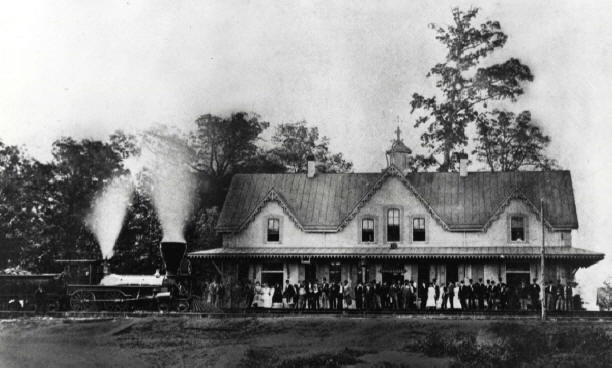The Railroad Station
It was in “Two Little Knights of Kentucky” that you first became acquainted with the “Lloydsboro Valley” Station. The station however remained a fixture throughout the Little Colonel books.
Located just across from the village main street, (“The Beeches” and Edgewood, the home of the MacIntyre’s would have been but a five minute walk straight out the front door crossing the tracks) its former space is now occupied by Kentucky State Highway 146 which runs parallel to the remaining tracks. These days, a caboose (on this side of the tracks) is symbolic for the old station.
The picture above shows the depot as it looked at its opening in 1867. The station was one of the stops on the Louisville & Frankfort Line. It was a sturdy building constructed of hand-made brick. 93 years later, in 1960, the old station was torn down.
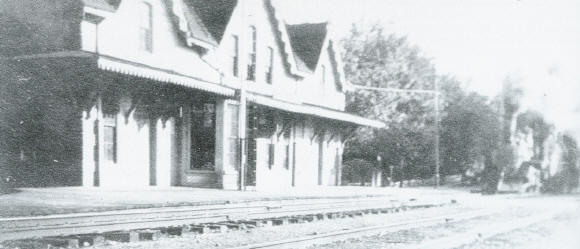
This station functioned for years as a classic small-town railroad station. The station served as a community center in as many was as it was a transportation hub. Readers of the Little Colonel books understand this well.
In 1881 the station and the line was acquired by the L&N Railroad. In fact, by the time of the Little Colonel Stories, the President of L&N (Milton H Smith) and a number of other L&N officials lived in Pewee (Lloydsboro) Valley and commuted to work in Louisville. The station was also a draw for for throngs of people who came to the tranquil valley and stayed at the 100 room Villa Ridge Inn, later the home for Confederate veterans. It was a time when at least one writer remarked that “all the world was on a holiday.”
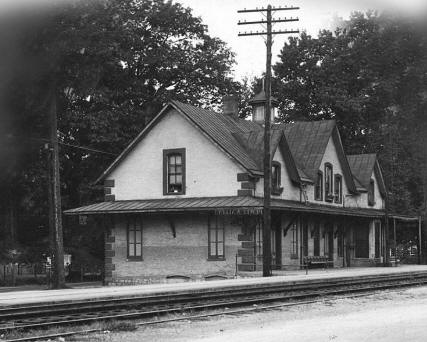
1936 photo of the Pewee Valley Railroad Station
from the Herald-Post photographs collection, ca. 1920-1936
klgsc:klgsculrsc021:94.18.0354
It was in this context that Little Colonel readers came to know this little depot. It was a time when, every day, dozens of horse drawn carriages would come and wait at the station for the days arrivals, whether it was “Miss Allison” on a days commute to Louisville, or “Phil Tremont” coming all the way from Arizona.
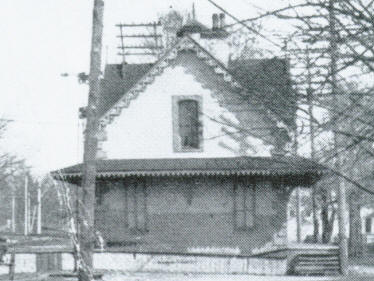
A few other things we’ve found out about this station:
- In 1895, boxing matches were held in the open area by the station.
- in 1912, the building became the temporary telephone exchange when the regular exchange, across the street, burned.
- A butcher’s shop operated in the basement at one time
- Women’s clubs held food sales and bazaars in the waiting room in later years.
- The station was closed in 1933, the end of rail service to the Valley.
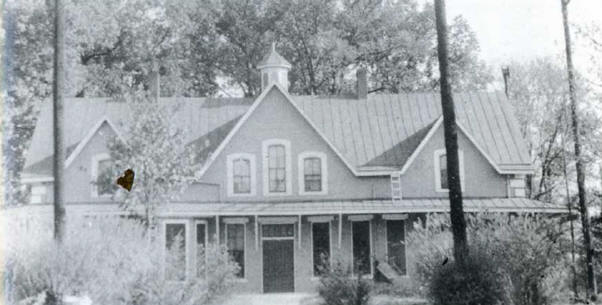
Sometime between 1933 and 1960, after the trains stopped running.
This shows the east side of the building (street entrance)
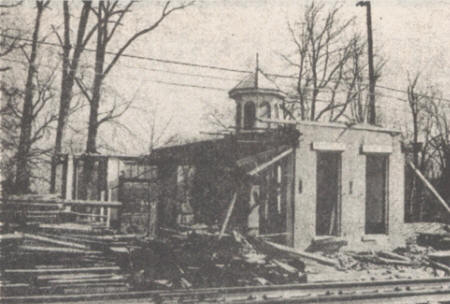
The Station comes to a sad end, March 1960
As workmen moved in with the wrecking balls, dozens of Pewee Valley residents gathered and took souvenirs of hand made brick and pieces of the poplar, oak and ash woodwork from the building. Not everyone was happy to see the old station go. Not by a long shot.
Pewee Valley Train Station The following article appeared in a bicentennial edition of the “Call of the Pewee.”
A story in the newspaper last week told of the razing of the Pewee Valley station. The 93-year-old structure, according to the Times was “a symbol of what long time Pewee residents consider the Oldham County town’s finest period — 1867, when the depot opened, through the early 1900s.” Victorian gingerbread that once proudly adorned its front had been removed in later years, but otherwise its appearance must have been much the same as on the gala opening day. The automobile put an end to its usefulness by 1933, and since then no trains have stopped there.
Miss Mary G. Johnston, daughter of Annie Fellows Johnston, author of the “Little Colonel” books, recalls the station in its heyday when “each evening it was a scene of great excitement when horse-drawn rigs met the men as they returned from their offices in Louisville. And ice-cream never tasted as good as it did on the station platform with cinders in it.”
I have never been a resident of Pewee Valley. In fact, I have been there very few times in my life. But to every Louisvillian of the female gender and my vintage, Pewee Valley is surely a perennial land of romance peopled still by Mrs. Johnston’s unforgettable characters. Nothing that happens there, even the razing of an antiquated railroad station, can leave me quite untouched. For here was the opening scene of “Two Little Knights of Kentucky .” Into “the little country depot” where “a long row of icicles hung from the eaves” and the wind “shivered down the long stovepipe inside the waiting room” came the two McIntyre boys, Malcolm and Keith, to bring their adventure with Jonesy and the bear.
Surely, to this same station, must have come Betty, Joyce and rich Eugenia to join the Little Colonel’s house party. On this same platform, suitcase in hand, must have stepped wayward Ida Shane on her way to boarding school in Lloydsborough Valley. And from this station, too, a radiant Lloyd must have set forth with Rob Moore on her honeymoon in that most romantic book of them all, “The Little Colonel’s Knight Comes Riding.”
When Mrs. Johnston was asked by countless readers if Lloydsborough Valley was a real place, she wrote in 1929:
“You will find it on a map of Oldham County under the name of Pewee Valley, but will still never find it now along any road whatsoever where you may go on a pilgrimage, for the years have stolen its pristine charm and it is no longer a storybook sort of place.
“But 30 years ago, wandering down its shady avenues was like stepping between the covers of an old romance. One had only to stroll past the little country post office to feel the glamour of the place and meet a host of interesting characters. In those days the post office, at nine o’clock of a summer morning, was the social center for an animated half hour or more.
“The smart equipages of summer residents were drawn up to the front of it. Old family carryalls loaded with children in care of black mammies joined the procession, and pretty girls and their escorts on horseback drew rein in the shade of locusts arching the road… “There was much visiting back and forth among the carriages while they waited. Picnics and parties were planned, invitations given and accepted, recipes exchanged and gossip passed from group to group. A stranger seeing the gay assemblage would conclude that the whole world was on holiday.”
Pewee Valley began life under the unglamorous name of Smith’s Station. The Louisville Herald of August 13, 1922 credits one Tom Smith, “a relative of Henry Clay,” with its founding in 1852. Mr. Smith was manager of a general store and train station agent when the first railroad line was built. Henry Smith, a relative of the aforementioned Tom, served as one of the town’s original trustees and laid out its streets, planting many of the ash, maple and locust trees that give the avenues their names today.
There are two schools of thought about the changing of the town’s name. One story gives the credit to Noble Butler, the grammarian, and a group of servants who gathered at the Smiths Station house. Another legend says the change was accomplished by the trustees, when the town was duly incorporated by an act of the Kentucky legislature on March 21, 1870. Both stories agree, however, about the appearance of a small brown bird at the psychological moment that uttered the cheerful call, “Pee Wee,” furnishing the inspiration for half of the town’s title. The “Valley” part remains a mystery, since Pewee “claims a greater elevation than any hill in Jefferson County.”
In COLLINS’S “History of Kentucky” (1874 edition) this town is described as “the most beautiful of suburban villages of Louisville; 17 miles from that city on the L, C and E rail road; has three churches (Presbyterian, Episcopalian, Roman Catholic); two hotels, four stores, one physician, population about 250.” Five of the town’s original seven trustees were prominent Louisville men who went daily to their business in the city. These were Orville Truman, John M. Armstrong, Milton M. Rhorer, J. George Dodge, and Charles B. Cotton. Mr. Smith and William Keely were the two others. Some of the well-known Louisvillians who had homes in Pewee Valley in the 1870s included John Van Horne, Alexander Craig, Judge P.B. Muir, Jonas H. Rhorer, Major Charles J. F. Allen and Thomas P. Barclay.
Older Louisvillians remember spending summers at the Villa Ridge Inn, which later became the Confederate Soldier’s Home. “The Locusts,” too, operated for awhile as a summer boarding house. The Kentucky School for Women, established in 1860, flourished for a number of years and was one of the valley’s assets. We have room to mention only a few of those whose lives were linked with Pewee Valley. These include the families of Col. George Weissinger, Hoadley Cochran, George Weissinger Smith, Thomas Floyd Smith, Charles Ross, Darwin Johnson, Milton H. Smith, Powhatan Wooldridge, the Rev. Peyton Hoge, James Buckner, Misses Kate and Florence Matthews, Merton and Miss Fanny Craig, Mrs. Albert Willis, Miss May Dulaney, Frank Gatchel and many others.
Miss Johnston still lives in her mother’s home, “The Beeches.” Little girls and those no longer girls still make pilgrimages to the “Land of the Little Colonel,” which, as Mrs. Johnston once wrote, is like “all Gaul, divided into three parts. One lies in Kentucky, one in the country of Imagination, and one in the dear demesne of Memory.”
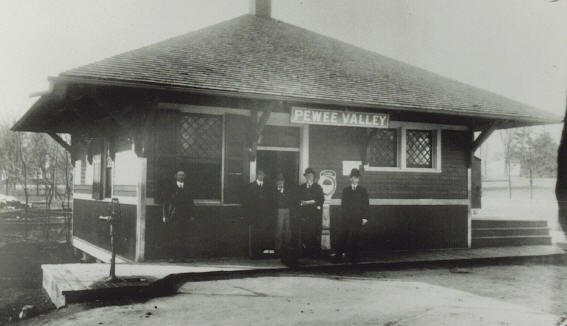
By the later Little Colonel Books, The Interurban lines were were running regular local service
from Louisville to LaGrange through Pewee Valley
Pictured here is the Interurban Station mentioned in the later Little Colonel stories
